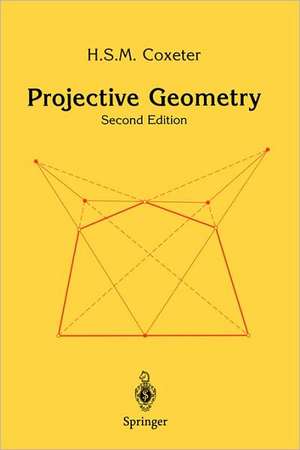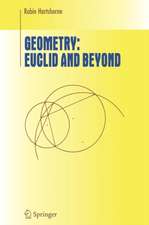Projective Geometry
Autor H.S.M. Coxeteren Limba Engleză Paperback – 9 oct 2003
Preț: 347.80 lei
Nou
Puncte Express: 522
Preț estimativ în valută:
66.56€ • 68.76$ • 55.39£
66.56€ • 68.76$ • 55.39£
Carte tipărită la comandă
Livrare economică 25 martie-08 aprilie
Preluare comenzi: 021 569.72.76
Specificații
ISBN-13: 9780387406237
ISBN-10: 0387406239
Pagini: 162
Ilustrații: XII, 162 p.
Dimensiuni: 155 x 235 x 8 mm
Greutate: 0.25 kg
Ediția:2nd ed. 1974. 2nd printing 2003
Editura: Springer
Colecția Springer
Locul publicării:New York, NY, United States
ISBN-10: 0387406239
Pagini: 162
Ilustrații: XII, 162 p.
Dimensiuni: 155 x 235 x 8 mm
Greutate: 0.25 kg
Ediția:2nd ed. 1974. 2nd printing 2003
Editura: Springer
Colecția Springer
Locul publicării:New York, NY, United States
Public țintă
Lower undergraduateCuprins
1 Introduction.- 1.1 What is projective geometry?.- 1.2 Historical remarks.- 1.3 Definitions.- 1.4 The simplest geometric objects.- 1.5 Projectivities.- 1.6 Perspectivities.- 2 Triangles and Quadrangles.- 2.1 Axioms.- 2.2 Simple consequences of the axioms.- 2.3 Perspective triangles.- 2.4 Quadrangular sets.- 2.5 Harmonic sets.- 3 The Principle of Duality.- 3.1 The axiomatic basis of the principle of duality.- 3.2 The Desargues configuration.- 3.3 The invariance of the harmonic relation.- 3.4 Trilinear polarity.- 3.5 Harmonic nets.- 4 The Fundamental Theorem and Pappus’s Theorem.- 4.1 How three pairs determine a projectivity.- 4.2 Some special projectivities.- 4.3 The axis of a projectivity.- 4.4 Pappus and Desargues.- 5 One-dimensional Projectivities.- 5.1 Superposed ranges.- 5.2 Parabolic projectivities.- 5.3 Involutions.- 5.4 Hyperbolic involutions.- 6 Two-dimensional Projectivities.- 6.1 Projective collineations.- 6.2 Perspective collineations.- 6.3 Involutory collineations.- 6.4 Projective correlations.- 7 Polarities.- 7.1 Conjugate points and conjugate lines.- 7.2 The use of a self-polar triangle.- 7.3 Polar triangles.- 7.4 A construction for the polar of a point.- 7.5 The use of a self-polar pentagon.- 7.6 A self-conjugate quadrilateral.- 7.7 The product of two polarities.- 7.8 The self-polarity of the Desargues configuration.- 8 The Conic.- 8.1 How a hyperbolic polarity determines a conic.- 8.2 The polarity induced by a conic.- 8.3 Projectively related pencils.- 8.4 Conics touching two lines at given points.- 8.5 Steiner’s definition for a conic.- 9 The Conic, Continued.- 9.1 The conic touching five given lines.- 9.2 The conic through five given points.- 9.3 Conics through four given points.- 9.4 Two self-polar triangles.- 9.5 Degenerate conies.- 10 A Finite Projective Plane.- 10.1 The idea of a finite geometry.- 10.2 A combinatorial scheme for PG(2, 5).- 10.3 Verifying the axioms.- 10.4 Involutions.- 10.5 Collineations and correlations.- 10.6 Conies.- 11 Parallelism.- 11.1 Is the circle a conic?.- 11.2 Affine space.- 11.3 How two coplanar lines determine a flat pencil and a bundle.- 11.4 How two planes determine an axial pencil.- 11.5 The language of pencils and bundles.- 11.6 The plane at infinity.- 11.7 Euclidean space.- 12 Coordinates.- 12.1 The idea of analytic geometry.- 12.2 Definitions.- 12.3 Verifying the axioms for the projective plane.- 12.4 Projective collineations.- 12.5 Polarities.- 12.6 Conics.- 12.7 The analytic geometry of PG(2, 5).- 12.8 Cartesian coordinates.- 12.9 Planes of characteristic two.- Answers to Exercises.- References.
Textul de pe ultima copertă
In Euclidean geometry, constructions are made with a ruler and compass. Projective geometry is simpler: its constructions require only a ruler. In projective geometry one never measures anything, instead, one relates one set of points to another by a projectivity.
This classic book introduces the important concepts of the subject and provides the logical foundations, including the famous theorems of Desargues and Pappus and a self-contained account of von Staudt's approach to the theory of conics. The modern approach used in this account is then utilized to deal with the simplest finite geometry that is rich enough to illustrate all the theorems nontrivially. The book concludes by demonstrating the connections among projective, Euclidean, and analytic geometry.
From the reviews of Projective Geometry:
...The book is written with all the grace and lucidity that characterize the author's other writings. ...
-T. G. Room, Mathematical Reviews
This is an elementary introduction to projective geometry based on the intuitive notions of perspectivity and projectivity and, formally, on axioms essentially the same as the classical ones of Vebber and Young...This book is an excellent introduction.
- T. G. Ostrom, Zentralblatt
This classic book introduces the important concepts of the subject and provides the logical foundations, including the famous theorems of Desargues and Pappus and a self-contained account of von Staudt's approach to the theory of conics. The modern approach used in this account is then utilized to deal with the simplest finite geometry that is rich enough to illustrate all the theorems nontrivially. The book concludes by demonstrating the connections among projective, Euclidean, and analytic geometry.
From the reviews of Projective Geometry:
...The book is written with all the grace and lucidity that characterize the author's other writings. ...
-T. G. Room, Mathematical Reviews
This is an elementary introduction to projective geometry based on the intuitive notions of perspectivity and projectivity and, formally, on axioms essentially the same as the classical ones of Vebber and Young...This book is an excellent introduction.
- T. G. Ostrom, Zentralblatt











